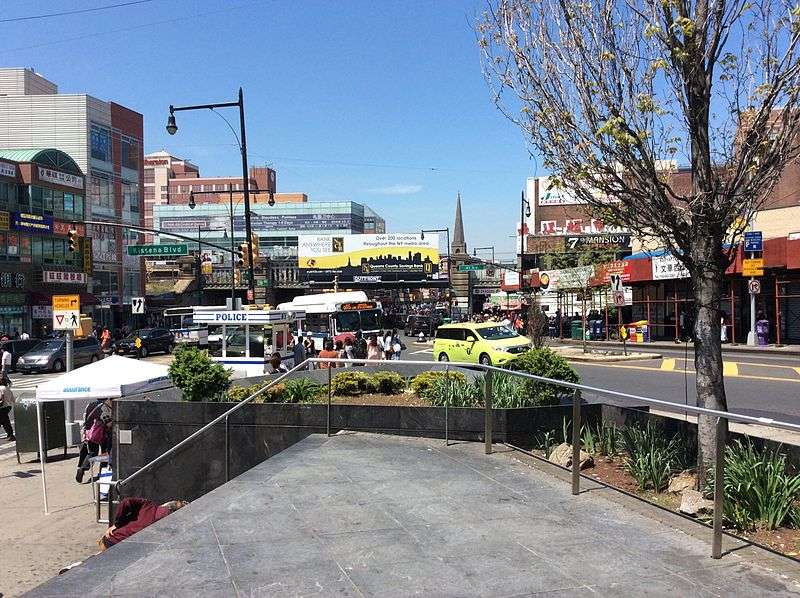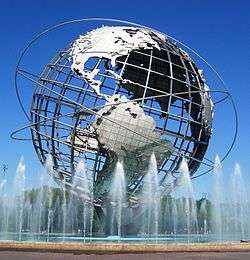Chinatowns in Queens
There are multiple Chinatowns in the borough of Queens in New York City. The original Queens Chinatown emerged in Flushing, initially as a satellite of the original Manhattan Chinatown, before evolving its own identity, surpassing in scale the original Manhattan Chinatown,[1] and subsequently in turn spawning its own satellite Chinatowns in Elmhurst, Corona, and eastern Queens.
| Chinatowns in Queens | |||||||
|---|---|---|---|---|---|---|---|
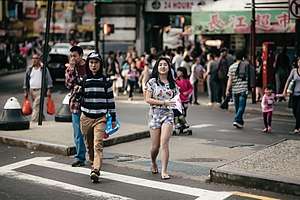 Intersection of Main Street, Kissena Boulevard, and 41st Avenue in Flushing Chinatown (法拉盛華埠) | |||||||
| Traditional Chinese | 皇后區唐人街 | ||||||
| Simplified Chinese | 皇后区唐人街 | ||||||
| |||||||
Context
The New York metropolitan area contains the largest ethnic Chinese population outside Asia, comprising an estimated 893,697 uniracial individuals as of 2017,[2] including at least 12 Chinatowns - six[3] (or nine, including the emerging Chinatowns in Corona and Whitestone, Queens,[4] and East Harlem, Manhattan) in New York City proper, and one each in Nassau County, Long Island; Cherry Hill, Edison, New Jersey;[4] and Parsippany-Troy Hills, New Jersey, not to mention fledgling ethnic Chinese enclaves emerging throughout the New York City metropolitan area. Chinese Americans, as a whole, have had a significant tenure in New York City. The first Chinese immigrants came to Lower Manhattan around 1870, looking for the "golden" opportunities America had to offer.[5] By 1880, the enclave around Five Points was estimated to have from 200 to as many as 1,100 members.[5]
However, the Chinese Exclusion Act, which went into effect in 1882, caused an abrupt decline in the number of Chinese who immigrated to New York and the rest of the United States.[5] Later, in 1943, the Chinese were given a small quota, and the community's population gradually increased until 1968, when the quota was lifted and the Chinese American population skyrocketed.[5] In the past few years, the Cantonese dialect that has dominated the Chinatowns for decades is being rapidly swept aside by Mandarin Chinese, the national language of China and the lingua franca of most of the latest Chinese immigrants.[6]
Citywide demographics
As the city proper with the largest ethnic Chinese population outside of Asia by a wide margin, estimated at 628,763 as of 2017,[7] and as the primary destination for new Chinese immigrants,[8] New York City is subdivided into official municipal boroughs, which themselves are home to significant Chinese populations, with Brooklyn and Queens, adjacently located on Long Island, leading the fastest growth.[9][10] After the City of New York itself, the boroughs of Queens and Brooklyn encompass the largest Chinese populations, respectively, of all municipalities in the United States.
| Rank | Borough | Chinese Americans | Density of Chinese Americans per square mile in borough | Percentage of Chinese Americans in borough's population |
|---|---|---|---|---|
| 1 | Queens, Chinatowns (皇后華埠) (2014)[11] | 237,484 | 2,178.8 | 10.2 |
| 2 | Brooklyn, Chinatowns (布魯克林華埠) (2014)[12] | 205,753 | 2,897.9 | 7.9 |
| 3 | Manhattan, Chinatown (曼哈頓華埠) (2014)[13] | 107,609 | 4,713.5 | 6.6 |
| 4 | Staten Island (2012) | 13,620 | 232.9 | 2.9 |
| 5 | The Bronx (2012) | 6,891 | 164 | 0.5 |
| New York City (2014) | 573,388[14] | 1,881.1 | 6.8 |
Flushing Chinatown (法拉盛華埠)
Flushing Chinatown | |
|---|---|
Neighborhood of Queens | |
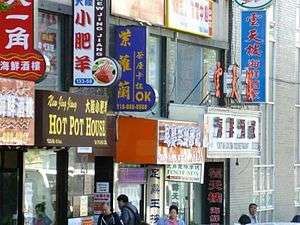 41st Avenue in Flushing Chinatown | |
| Country | United States of America |
| State | New York |
| City | New York City |
| Borough | Queens |
| Region | Long Island |
| Area code(s) | 718, 347, 929, and 917 |
| Chinatown, Flushing | |||||||||||||||||||||
|---|---|---|---|---|---|---|---|---|---|---|---|---|---|---|---|---|---|---|---|---|---|
| Traditional Chinese | 法拉盛華埠 | ||||||||||||||||||||
| Simplified Chinese | 法拉盛华埠 | ||||||||||||||||||||
| |||||||||||||||||||||
Flushing Chinatown (法拉盛華埠), or Mandarin Town Flushing (國語埠法拉盛)[16] in Flushing, is one of the largest and fastest growing ethnic Chinese enclaves outside Asia, as well as within New York City itself. Flushing Chinatown is in Main Street and the area to its west, particularly along Roosevelt Avenue, have become the primary nexus of Flushing Chinatown. However, Chinatown continues to expand southeastward along Kissena Boulevard and northward beyond Northern Boulevard. The Flushing Chinatown houses over 30,000 individuals born in China alone, the largest Chinatown by this metric outside Asia and one of the largest and fastest-growing Chinatowns in the world.[1] Conversely, the Flushing Chinatown has also become the epicenter of organized prostitution in the United States.[17]
History
Before Chinatown
In 1645, Flushing was established by Dutch settlers on the eastern bank of Flushing Creek under charter of the Dutch West India Company and was part of the New Netherland colony. The settlement was named after the city of Vlissingen, in the southwestern Netherlands, the main port of the company; Flushing is the historic anglicization of the Dutch name of that town.
In 1664, the English took control of New Amsterdam, ending Dutch control of the colony, and renamed it the Province of New York. When Queens County was established in 1683, the "Town of Flushing" was one of the original five towns which comprised the county.[18] Many historical references to Flushing are to this town, bounded from Newtown on the west by Flushing Creek (now often called the Flushing River), from Jamaica on the south by the "hills"—that is, the terminal moraine left by the last glacier, and from Hempstead on the east by what later became the Nassau County line. The town was dissolved in 1898 when Queens became a borough of New York City, and the term "Flushing" today usually refers to a much smaller area, including the former Village of Flushing and the areas immediately to the east and south. It was later settled by multiple ethnic groups, including people of European, Hispanic, Middle Eastern, African American, and eventually Asian ancestry.
Emergence as Little Taipei / Little Taiwan
In the 1970s, a Chinese community established a foothold in Flushing, whose demographic constituency had been predominantly Caucasian, interspersed with a small Japanese community. This wave of immigrants from Taiwan were the first to arrive and developed Flushing's Chinatown. It was known as Little Taipei (小台北) or Little Taiwan (小台灣). Many who arrived were the descendants of former soldiers and political supporters of Chiang Kai-shek and the Chinese Nationalist Party, which had lost the war against the Communist Party of China, and established themselves in Taiwan. Along with immigrants from Taiwan at this time, a large South Korean population has also called Flushing home.
Before the 1970s, Cantonese immigrants had vastly dominated Chinese immigration to New York City; however, during the 1970s, the Taiwanese immigrants were the first wave of Chinese immigrants who spoke Mandarin rather than Cantonese to arrive in New York City. Due to the dominance of Cantonese-speaking immigrants, who were largely working-class in Manhattan's Chinatown (紐約華埠), as well as the language barrier and poor housing conditions there, Taiwanese immigrants, who were more likely to have attained higher educational standards and socioeconomic status, could not relate to Manhattan's Chinatown, and chose to settle in Flushing instead. As the Taiwanese population grew, a Flushing Chinatown was created with a higher standard of living and better housing conditions.
Mandarin Town, Flushing
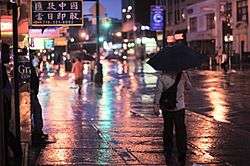
Over the years, many new non-Cantonese ethnic Chinese immigrants from different regions and provinces of China started to arrive in New York City and settled in Flushing through word of mouth. This led to the creation of a more Mandarin-speaking Chinatown or Mandarin Town that gradually replaced Little Taipei. This wave of immigrants spoke Mandarin and various regional/provincial dialects. The early 90s and 2000s brought a wave of Fuzhounese Americans and Wenzhounese immigrants. Like the Taiwanese, they faced cultural and communication problems in Manhattan's dominant Cantonese-speaking Chinatown and settled in Flushing as well as Elmhurst, Queens, which also has a significant Mandarin-speaking population. Flushing's Chinese population became very diverse over the next few decades as people from different provinces started to arrive, infusing their varied languages and cultures into this new "Chinatown." [19][20][21][22] Due to the increased opening of Mainland China, there has also been a growing Northern Chinese population in Flushing.
Flushing and its Chinatown abuts the rapidly growing Long Island Koreatown (롱 아일랜드 코리아타운) as well.[23]
Chinese demographic
The intersection of Main Street and Roosevelt Avenue, in the heart of the Chinatown neighborhood, hosts a large concentration of Chinese businesses, including Chinese restaurants. Chinese-owned businesses in particular dominate the area along Main Street and the blocks west of it, while Korean businesses are found in a substantial number east of Main Street and east of the Flushing Chinatown, on Union Street. The majority of signs and advertisements of stores in the area have become Chinese. Ethnic Chinese constitute an increasingly dominant proportion of the Asian population and as well as of the overall population in Flushing. Consequently, Flushing's Chinatown has grown rapidly enough to become the largest Chinatown outside Asia. The Flushing Chinatown has surpassed the original Manhattan Chinatown in size.[1]
A 1986 estimate by the Flushing Chinese Business Association approximated 60,000 Chinese in Flushing alone.[24] By 1990, Asians constituted 41% of the population of the core area of Flushing, with Chinese in turn representing 41% of the Asian population.[19] However, ethnic Chinese are constituting an increasingly dominant proportion of the Asian population as well as of the overall population in Flushing and its Chinatown. High rates of both legal[25][26] and illegal[27] immigration from Mainland China continue to spur the ongoing rise of the ethnic Chinese population in Flushing, as in all of New York City's Chinatowns.

Flushing's Chinatown ranks as New York City's second-largest Chinese community with 33,526 Chinese, up from 17,363, a 93% increase. The Brooklyn Chinatown (布鲁克林華埠) is the second-the largest Chinatown of NYC with 34,218 Chinese residents, up from 19,963 in 2000, a 71% increase. As for Manhattan's Chinatown, its Chinese population declined by 17%, from 34,554 to 28,681 since 2000, to become the third-largest.[28]
Of all the Chinatowns of New York City, the Flushing Chinatown is also the most diverse, with large populations of Chinese groups from various regions of Mainland China and Taiwan. The Northeastern Chinese immigrants are increasingly becoming the largest Chinese group in Flushing.[29][30][31][32][33][34][35]
Streetscape
Culture
Flushing Chinatown now rivals Manhattan's Chinatown as a center of Chinese culture[37] and has been called the "Chinese Times Square" or the "Chinese Manhattan".[38][39] The Lunar New Year Parade has become a growing annual celebration of Chinese New Year. More and larger Chinese supermarkets are locating and selling a diverse and uniquely vast array of Chinese food and ingredient selections in Flushing, the largest of which include Hong Kong Supermarket and New York Supermarket, which also happen to be rapidly growing Chinese American chain supermarkets.[40][41][42] The segment of Main Street between Roosevelt Avenue and Kissena Boulevard represents the cultural heart of Flushing Chinatown. Flushing's rise as an epicenter of Chinese culture outside Asia has been attributed to the remarkable diversity of regional Chinese demographics represented.
Languages
Mandarin Chinese[43] (including Northeastern Mandarin), Fuzhou dialect, Min Nan Fujianese, Wu Chinese, Beijing dialect, Wenzhounese, Shanghainese, Suzhou dialect, Hangzhou dialect, Cantonese, Taiwanese, and English are all prevalently spoken in Flushing Chinatown, while Hakka and the Mongolian language are now emerging.
Cuisine
The popular styles of Chinese cuisine are ubiquitously accessible in Flushing,[44] including Hakka, Taiwanese, Shanghainese, Hunanese, Szechuan, Cantonese, Fujianese, Xinjiang, Zhejiang, and Korean Chinese cuisine. Even the relatively obscure Dongbei style of cuisine indigenous to Northeast China is now available in Flushing,[45] as well as Mongolian cuisine and Uyghur cuisine.[39] These diverse Chinese immigrant populations have brought with them their own regional food cuisines which have led to Flushing being considered the "food mecca" for Chinese regional cuisine outside of Asia.[46][47]
Media
The World Journal, one of the largest Chinese-language newspapers outside China, is headquartered in adjacent Whitestone (白石), Queens, with offices in Flushing as well.[48] Numerous other Chinese newspapers such as the China Press, Sing Tao Daily, The Epoch Times, as well as other English-language publications, are available in the Flushing Chinatown.
SinoVision, one of the largest Chinese-speaking media networks in North America also has headquarters in Flushing.
Educational centers
In accompaniment with its rapid growth, Flushing in particular has witnessed the proliferation of highly competitive businesses touted as educational centers[49] as well as non-profit organizations declaring the intent to educate the community. Some entities offer education in Mandarin,[50] the lingua franca of Mainland China; others profess to provide students with intensive training in computer and technological proficiency; while still others entice high school students with rigorous preparatory classes for college entrance examinations in mathematics, science, and English literacy (see: cram school and buxiban).
Public institutions and services
The largest of the Flushing branches of the Queens Borough Public Library is located at the intersection of Kissena Boulevard and Main Street.[51] This library houses an auditorium for public events.
New York Hospital Queens, a member of the NewYork-Presbyterian Healthcare System, is a major medical center providing Flushing as well as surrounding communities with comprehensive medical care services.[52] Numerous tertiary medical clinics also serve the residents of Flushing.
A diverse array of social services geared toward assisting recent as well as established Chinese immigrants is readily available in Flushing.[53]
Transportation
The New York City Subway's 7 and <7> trains has its terminus at Flushing – Main Street; the intersection of Main Street and Roosevelt Avenue, at the heart of Flushing Chinatown, is the third busiest intersection in New York City, behind only Times Square and Herald Square in Manhattan. It is the busiest subway station in Queens and the 12th busiest station overall As of 2016.[54] Numerous other public bus and rail connections also serve Chinatown at the Main Street/Roosevelt Avenue intersection, including 22 bus routes as well as the Port Washington Branch branch of the Long Island Rail Road.[55] Flushing Chinatown is also readily accessible by automobile from several major highways, namely the Grand Central Parkway and the Whitestone Expressway/Van Wyck Expressway. There are also multiple dollar van services shuttling passengers between Flushing Chinatown and the other Chinatowns in New York City and Long Island.
Political clout
The political stature of Flushing Chinatown appears to be increasing significantly. Taiwan-born John Liu, former New York City Council member representing District 20, which includes Flushing Chinatown and other northern Queens neighborhoods, was elected New York City Comptroller in November 2009. Concomitantly, Peter Koo, born in Shanghai, China was elected to succeed Liu to assume this council membership seat.
Controversy
In March 2019, The New York Times reported that the Flushing Chinatown has also become the epicenter of organized prostitution in the United States, importing women from China, Korea, Thailand, and Eastern Europe to sustain the underground North American sex trade.[57]
Satellite Chinatowns
Chinatown in Elmhurst
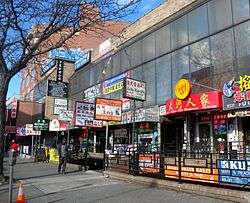
Elmhurst's rapidly growing Chinatown (艾浒 唐人街)[58] is the second in Queens, in addition to the Flushing Chinatown. Previously a small area with Chinese shops on Broadway between 81st Street and Cornish Avenue, this newly evolved second Chinatown in Queens has now expanded to 45th Avenue and Whitney Avenue and is developing as a satellite of the Flushing Chinatown. In Chinese translation, Elmhurst is named 艾浒 (Àihǔ in Standard Chinese). There are also many other Southeast Asian businesses and shops in the area, including Malaysian Chinese, Singaporean Chinese, Indonesian, Thai, and Vietnamese. Hong Kong Supermarket and New York Supermarket serve as the largest Chinese supermarkets selling different food varieties to this Elmhurst Chinatown.[59][60] Financial institutions have emerged along Broadway to serve the various Chinese communities of Elmhurst. Like Flushing's Chinatown, it is also very highly populated by Mandarin speakers, although many also speak other languages like Hakka.
Chinese enclave in Corona
An annexation of the Elmhurst Chinatown is the neighborhood of Corona, emerging as a Chinatown geographically connecting the larger Chinatowns in Flushing and Elmhurst.[61]
Chinese enclave in Whitestone
Since 2000, thousands of Chinese Americans have migrated into Whitestone (白石), given the sizeable presence of the neighboring Flushing Chinatown, and have continued their expansion eastward in Queens and into neighboring, highly educated Nassau County (拿騷縣) on Long Island (長島).[62][63][64] The World Journal, the largest Chinese-language newspaper in the United States[62] and one of the largest Chinese-language newspapers outside China, with a daily circulation of 350,000, is headquartered in Whitestone.[48] The New York office of Hong Kong-based Lee Kum Kee International Holdings Ltd. is also located in Whitestone.[65]
See also
Chinatowns:
- Chinatown
- Chinese Americans in New York City
- Chinatowns in Brooklyn (布鲁克林華埠)
- Chinatown, Manhattan (紐約華埠)
- Little Hong Kong/Guangdong(小香港/廣東)
- Little Fuzhou (小福州)
- Chinatown, Avenue U (唐人街, U大道)
- Chinatown, Bensonhurst (唐人街, 本森社区)
- Chinatowns in Canada and the United States
- List of Chinatowns in the United States
Koreatowns:
References
- Melia Robinson (May 27, 2015). "This is what it's like in one of the biggest and fastest growing Chinatowns in the world". Business Insider. Retrieved July 23, 2017.
- "SELECTED POPULATION PROFILE IN THE UNITED STATES 2017 American Community Survey 1-Year Estimates New York-Newark, NY-NJ-CT-PA CSA Chinese alone". United States Census Bureau. Archived from the original on February 14, 2020. Retrieved January 27, 2019.
- Kirk Semple (June 23, 2011). "Asian New Yorkers Seek Power to Match Numbers". The New York Times. Retrieved 2014-10-03.
- Lawrence A. McGlinn (2002). "Beyond Chinatown: Dual Immigration and the Chinese Population of Metropolitan New York City, 2000" (PDF). Middle States Geographer. 35 (1153): 4. Archived from the original (PDF) on 2012-10-29. Retrieved 2014-10-03.
- Waxman, Sarah. "The History of New York's Chinatown". ny.com. Retrieved 2014-10-03.
- Semple, Kirk (October 21, 2009). "In Chinatown, Sound of the Future Is Mandarin". The New York Times. Retrieved 2011-06-29.
- "ACS DEMOGRAPHIC AND HOUSING ESTIMATES 2017 American Community Survey 1-Year Estimates Chinese alone - New York City, New York". U.S. Census Bureau. Archived from the original on February 14, 2020. Retrieved February 15, 2019.
- "Yearbook of Immigration Statistics: 2012 Supplemental Table 2". U.S. Department of Homeland Security. Retrieved 2014-03-08.
- "Kings County (Brooklyn Borough), New York QuickLinks". U.S. Census Bureau. Archived from the original on 2014-03-04. Retrieved 2014-03-08.
- "Queens County (Queens Borough), New York QuickLinks". U.S. Census Bureau. Archived from the original on 2016-02-25. Retrieved 2014-03-08.
- "Selected Population Profile in the United States 2014 American Community Survey 1-Year Estimates – Queens County, New York Chinese alone". United States Census Bureau. Retrieved April 10, 2016.
- "Selected Population Profile in the United States 2014 American Community Survey 1-Year Estimates – Kings County, New York Chinese alone". United States Census Bureau. Retrieved April 10, 2016.
- "Selected Population Profile in the United States 2014 American Community Survey 1-Year Estimates – New York County, New York Chinese alone". United States Census Bureau. Retrieved April 10, 2016.
- "SELECTED POPULATION PROFILE IN THE UNITED STATES – 2014 American Community Survey 1-Year Estimates – New York City – Chinese alone". U.S. Census Bureau. Retrieved September 20, 2015.
- "Archived copy". Archived from the original on 2016-10-05. Retrieved 2016-06-28.CS1 maint: archived copy as title (link)
- Asian Americans: Contemporary Trends and Issues Second Edition, Edited by Pyong Gap Min. Pine Forge Press - An Imprint of Sage Publications, Inc. 2006. ISBN 978-1-4129-0556-5. Retrieved 2010-11-08.
- Nicholas Kulish, Frances Robles, and Patricia Mazzei (March 2, 2019). "Behind Illicit Massage Parlors Lie a Vast Crime Network and Modern Indentured Servitude". The New York Times. Archived from the original on March 6, 2019. Retrieved March 2, 2019.CS1 maint: multiple names: authors list (link)
- "Before the Five Borough City:Queens". This later map shows former boundaries of the Town of Flushing. The map does not show the towns that were part of Queens and are now part of Nassau.
- Foner, Nancy (2001). New immigrants in New York. Columbia University Press. pp. 158–161. ISBN 978-0-231-12414-0.
- Asian Americans: contemporary trends ... – Google Books. Books.google.com. Retrieved August 28, 2011.
- Chinatown: The Socioeconomic ... – Google Books. Books.google.com. January 24, 1995. Retrieved August 28, 2011.
- David M. Reimers. Still the golden door: the Third ... – Google Books. Books.google.com. Retrieved December 15, 2011.
- Asian Americans: Contemporary Trends and Issues Second Edition, Edited by Pyong Gap Min. Pine Forge Press - An Imprint of Sage Publications, Inc. 2006. ISBN 9781412905565. Retrieved 2013-01-11.
- Hsiang-shui Chen. "Chinese in Chinatown and Flushing". Retrieved 2010-03-29.
- "Yearbook of Immigration Statistics: 2011 Supplemental Table 2". U.S. Department of Homeland Security. Retrieved 2012-09-18.
- "Yearbook of Immigration Statistics: 2010 Supplemental Table 2". U.S. Department of Homeland Security. Retrieved 2012-09-18.
- John Marzulli (May 9, 2011). "Malaysian man smuggled illegal Chinese immigrants into Brooklyn using Queen Mary 2: authorities". New York: © Copyright 2012 NY Daily News.com. Retrieved 2012-09-18.
- Daniel Beekman (2011-08-05). "The changing Chinatowns: Move over Manhattan, Sunset Park now home to most Chinese in NYC". NY Daily News. Retrieved 2012-09-18.
- https://storymaps.arcgis.com/stories/3e851680ceeb498db44e6efe4095397b
- https://fordhamram.com/69896/culture/flushing-queens-the-other-chinatown/
- https://www.npr.org/2016/01/26/463857599/leaving-chinas-north-immigrants-redefine-chinese-in-new-york
- http://usa.chinadaily.com.cn/world/2014-06/30/content_17627657.htm
- https://www.nytimes.com/2015/04/16/nyregion/influx-of-chinese-immigrants-is-reshaping-large-parts-of-brooklyn.html
- https://www.brickunderground.com/live/neighborhood-secrets-what-to-know-about-living-in-manhattan-chinatown-nyc
- https://medium.com/flushing/flushing-where-mainland-chinese-immigrants-are-moving-in-42156f62943a
- "Selected Population Profile in the United States - 2016 American Community Survey 1-Year Estimates Queens County, New York Chinese alone". United States Census Bureau. Archived from the original on February 14, 2020. Retrieved December 28, 2017.
- Semple, Kirk (October 21, 2009). "In Chinatown, Sound of the Future Is Mandarin". The New York Times. Retrieved April 6, 2010.
- Haller, Vera (October 1, 2014). "Downtown Flushing: Where Asian Cultures Thrive". The New York Times. Retrieved July 30, 2017.
- Max Falkowitz (August 25, 2018). "A World of Food, Outside the U.S. Open Gates". The New York Times. Retrieved August 25, 2018.
- Freudenheim, Ellen. Queens: What to Do, Where to Go (and How Not to Get Lost) in New York's Undiscovered Borough. Macmillan. Retrieved December 15, 2011.
- Alperson, Myra (September 20, 2003). Nosh New York: The Food Lover's Guide to New York City's Most Delicious Neighborhoods. Macmillan. Retrieved July 30, 2017.
- Greenhouse, Steven (December 9, 2008). "Supermarket to Pay Back Wages and Overtime – NYTimes.com". Cityroom.blogs.nytimes.com. Retrieved July 30, 2017.
- Semple, Kirk (2009-10-21). "In Chinatown, Sound of the Future Is Mandarin". The New York Times. Retrieved 2011-07-16.
- Julia Moskin (2008-07-30). "Let the Meals Begin: Finding Beijing in Flushing". The New York Times. Retrieved 2011-06-26.
- Moskin, Julia (2010-02-09). "Northeast China Branches Out in Flushing". The New York Times. Retrieved 2011-05-09.
- "A Look at Tianjin Cuisine, Northern Chinese Fare Found in Flushing". eater.com. Retrieved April 14, 2018.
- "In Flushing, A Beacon for Northeastern Chinese Cuisine Shines Bright". villagevoice.com. Retrieved April 14, 2018.
- "Contact Us (Page in Chinese) World Journal. Retrieved on 2014-10-03. "New York Headquarters 141-07 20th Ave. Whitestone, NY 11357"
- Alice Yin (October 25, 2017). "Asian Test-Prep Centers Offer Parents Exactly What They Want: 'Results'". The New York Times Magazine. Retrieved October 26, 2017.
- Barry, Ellen (2007-05-28). "In Queens, Classes in Mandarin Are Also Lessons in Adaptation". The New York Times. Retrieved 2010-04-03.
- "Flushing". Queens Public Library. Retrieved 2012-02-23.
- "New York Hospital Queens". Archived from the original on 2010-06-19. Retrieved 2010-04-16.
- "Chinese Immigrants Services, Inc". Archived from the original on 2010-05-27. Retrieved 2010-04-07.
- "Facts and Figures: Annual Subway Ridership 2014–2019". Metropolitan Transportation Authority. 2020. Retrieved May 26, 2020.
- "MTA/New York City Transit Subway Line Information - Flushing-Main Street/Roosevelt Avenue". Retrieved 2010-04-15.
- "Tuidang Movement". Places to Go In US. Archived from the original on February 4, 2016. Retrieved September 14, 2015.
- Kulish, Nicholas; Robles, Frances; Mazzei, Patricia (2019-03-02). "Behind Illicit Massage Parlors Lie a Vast Crime Network and Modern Indentured Servitude". The New York Times. ISSN 0362-4331. Retrieved 2019-12-27.
- "A Growing Chinatown in Elmhurst". Retrieved 2010-10-01.
- "Nosh New York". Retrieved 12 April 2016.
- Greenhouse, Steven (December 9, 2008). "Supermarket to Pay Back Wages and Overtime". The New York Times.
- Lawrence A. McGlinn, Department of Geography SUNY-New Paltz. "Beyond Chinatown: Dual Immigration and the Chinese Population of Metropolitan New York City, 2000, Page 4" (PDF). Middle States Geographer, 2002, 35: 110–119, Journal of the Middle States Division of the Association of American Geographers. Archived from the original (PDF) on 2012-10-29. Retrieved 2013-03-19.
- Carol Hymowitz (2014-10-27). "One Percenters Drop Six Figures at Long Island Mall". Bloomberg L.P. Retrieved 2014-10-27.
- Heng Shao (2014-04-10). "Join The Great Gatsby: Chinese Real Estate Buyers Fan Out To Long Island's North Shore". Forbes. Retrieved 2014-10-03.
- Michelle Conlin and Maggie Lu Yueyang (2014-04-25). "The Chinese take Manhattan: replace Russians as top apartment buyers". Thomson Reuters. Retrieved 2014-11-28.
- "Contact Information Archived 2014-08-12 at the Wayback Machine." Lee Kum Kee. Retrieved on 2014-10-03. "30-56 Whitestone Expressway, Suite #350, Whitestone, NY 11354 USA"
